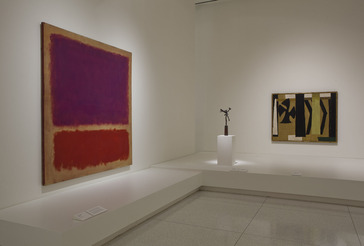Stopping by Rothko: Art, Memory, and Brain Science
December 06, 2016 • By Kristine A. Culp
As I walk to and from campus, I angle through the courtyard that opens to the University of Chicago’s Smart Museum, which holds Mark Rothko’s painting, No. 2, 1962. Even when I don’t enter, I am mindful of the Rothko there.
Mark Rothko came to his classic style of painting in 1949, modifying it somewhat before his death in 1970. His slightly-larger-than-human-scale paintings typically feature two or more rectangular fields of saturated color. The fields hover over and under one another, rarely resting on the edges of the unframed canvas. Some are bright and hot: yellow, red, magenta; others feature maroons shading to black. Built up through layers of thin color wash, these fields pulse with depth. But there is no real background or foreground to the paintings. It’s the viewer who is pulled in through luminous color, who is pushed back to comprehend the vibrating whole, and who is invited into and beyond the canvas.
If there is something “beyond the canvas” in Rothko’s paintings, it is a varied and enigmatic space. It is perhaps a kindred space to the endless plains and caverns of memory which the fourth century Saint Augustine explores in Book X of The Confessions. Memory’s terrain is “immeasurably full of countless things,” Augustine exclaims, “—in this wide land I am free of all of them, free to run and fly to and fro, to penetrate as deeply as I can, to collide with no boundary anywhere.”
To be free of all of them. Rothko the painter eschews—avoids, shuns—explanation, figural representation, symbolism, backgrounds, foregrounds, picture frames, and titles (he seems not even to have been the person who numbered his painting, “No. 2, 1962”). He follows modernism’s rejection of artistic conventions, follows them past orthodoxies of modern art, to collide with no boundary anywhere.
Today, brain science suggests that something like being freed to create new associations of thought, memory, emotion, and empathy is what, in fact, happens when someone views abstract art. In his 2016 book, Reductionism in Art and Brain Science: Bridging the Two Cultures, Nobel Prize-winning neuroscientist Eric R. Kandel explains that more regions of the brain are activated in viewing abstract art than in everyday interactions or in viewing figurative art. Figurative art relies on bottom-up visual processing, which allows facial recognition and the inference of depth and perspective. (The most engaging figurative works seem also to connect conscious and preconscious processing, thereby fostering creativity and a sense of self.) By contrast, the works of Rothko and other abstract artists “not only dismantle many of the building blocks of bottom-up visual processing…, they also nullify some of the premises on which bottom-up processing is based.” This visual ambiguity allows for, and even necessitates, the creation of new meaning. Top-down cognitive associations and emotional responses are recruited; memory, emotion, and empathy are brought into interpretive play. According to Kandel, “Abstract art dares our visual system to interpret an image that is fundamentally different from the kind of images our brain has evolved to reconstruct.”
Centuries before brain science began to parse the mystery of it, Augustine marveled at the infinite terrain of memory. Augustine did so ultimately to follow the sensory traces in memory beyond memory: “O sweetness that will never fail me, that I may find you … where?”
Rothko sometimes referred to his own paintings as performing a kind of sacramental or spiritual function, and that is how many appreciative viewers, Kandel among them, have encountered his work. He prized the intimate, chapel-like space of the Rothko room in the Phillips Collection, and his last commission was to design an ecumenical chapel in Houston. Intriguingly, Christopher Rothko reports that his father “spoke of having small chapels dotted throughout the country where the lone traveler could stop and encounter one of his paintings” (Mark Rothko: From the Inside Out).
Rothko once remarked, “The struggle is beyond painting, not with painting.” In response, James Breslin noted, “But he didn’t paint the beyond; he painted the struggle—as a difficult crossing into an unknown space where life appears on the verge of either a new start or a disintegration” (Mark Rothko: A Biography). Both Augustine’s Confessions and today’s frontiers of brain science illuminate this picture of the difficult, if sometimes exhilarating, confrontation with unknown spaces.
In this global age, life itself often appears “on the verge of either a new start or a disintegration.” We, as individuals and as fellow creatures with shared projects in a vast cosmos, are vulnerable to enhancement and to endangerment. Rothko’s paintings won’t tell us what or how to worship or, for that matter, what will enhance or endanger life. However, they can disrupt conventions and elicit new ways of attending to the ambiguous glories of life and its openness to the living mystery that extends beyond. So much seems possible - knowledge of the infinitesimal cellular exchanges of the brain and of the dark matter of the universe - and so much seems threatened or unsustainable. We will not fathom these vast enigmas, but stopping by Rothko may allow us to sense and to ponder the power and limits of our lives, and the responsibilities beyond our own selves to which we are summoned.
This blog post adapts and builds upon an UnCommon Core lecture, given for the University of Chicago Alumni Association in June 2016.
Installation image features: Mark Rothko, No. 2 (176.161); Richard Howard Hunt, Organic Construction No. 10 (1974.166); Robert Motherwell, Ile de France (2014.73); Smart Museum of Art